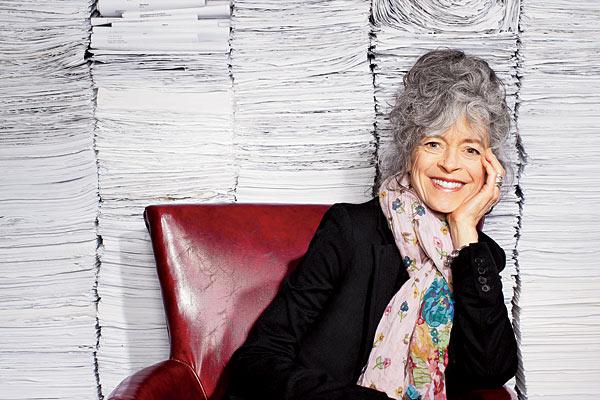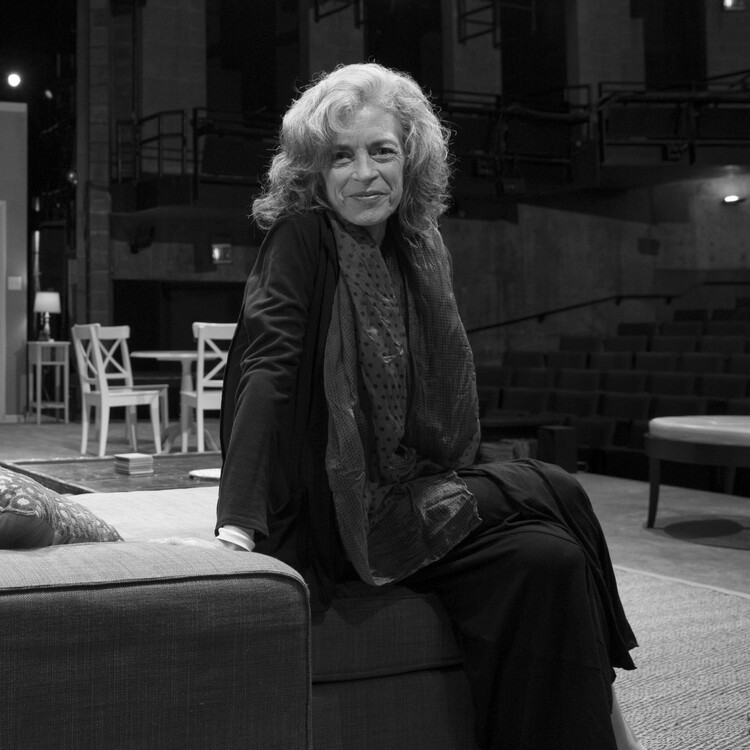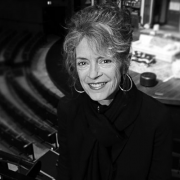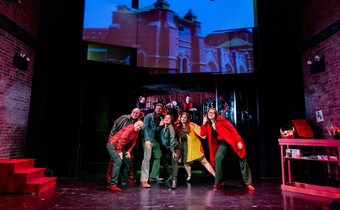P. Carl In Conversation with Martha Lavey
I'm heartbroken about the loss of Martha Lavey. She was a force of nature who had such a deep sense of purpose and her values were impeccable. I learned so much from her and will always be grateful for our time working together. She made our theatre better, and her generous spirit made the world better. Rest easy, dear Martha—you gave us so much.—P. Carl.
This article was originally published on HowlRound February 15, 2015.
A few years back, I had the distinct pleasure of working at Steppenwolf Theatre where Martha Lavey has been the artistic director since 1995. This past fall it was announced that Martha is stepping down at Steppenwolf to be succeeded by ensemble member Anna D. Shapiro. My time at Steppenwolf, and my relationship with Martha, in particular, helped shape my thinking about the nonprofit theatre as a citizen of the community. We spoke recently about her work at Steppenwolf, the role of the artistic director in a changing cultural and economic landscape, and what’s next for Martha.
P. Carl: What do you think is the responsibility of an artistic director in 2015? From my vantage point, it’s evolved significantly over the fifty years of the regional theatre movement—from managing an artistic company and subscribers to understanding the role of commercial partnerships—the economics have changed, the audience we’re talking to has changed. What are the big things ADs should be thinking about now?
Martha Lavey: I think that you captured a lot of it right there. If I’m not mistaken, in the past fifty years as the regional theatre movement was developing, it was really a conversation from the institution to the artist about creating a platform for artists and reaching an audience. The idea that the audience was somehow in an interactive relationship with the institution itself—much less the artist—wasn’t as active as it is now. As you and I both know, whether it’s in interacting with art, or whether it’s interacting with businesses in general, the agency that individuals feel in just interrogating that voice by questioning things about the idea of an institution has a different value; there’s not that kind of reverence for cultural institutions, right? And I don’t mean that there’s a patent irreverence, or that people don’t, in general, find them valuable, but the notion that these institutions have a kind of authoritative voice is relativized, is challenged. So I think being an artistic director means having a much bigger sense of who that community is, and I think the idea of who the community is has expanded, as well, in all kinds of ways. The notion, for instance, that an art institution should be somewhat representative of the voice of the community and not just the expression of high culture, those kind of boundaries have been effaced to a great deal.
I think it’s the responsibility of an artistic director…to say here’s the pull that I’m feeling in our community [and] to have a sort of eloquence or articulation around that, that maybe the community itself feels but does not deliver as a particular statement of need.
P. Carl: In your mind, how much is the role of an artistic leader to lead the community and how much is her role to respond to that community?
Martha: When is the leading and when is the responding? Is there some clear demarcation between those? I think it’s the responsibility of an artistic director, or let’s say, the collective, which is the artistic institution, to say here’s the pull that I’m feeling in our community. But, after all, isn’t it our responsibility to have a sort of eloquence or articulation around that, that maybe the community itself feels but does not deliver as a particular statement of need? So I think being sensitive to that, to me, is leadership, saying here’s what we feel is in the air and what we think is worthy of giving voice to. Aren’t we in that zone of asking what does that mean if the audience collectively is a group of people that wants to have more agency in the pulling direction, so what are they going to do—pick the plays? No, it doesn’t mean that. That’s not the expertise.
P. Carl: One of the things that, of course, has always impressed me about you, and it’s one of the reasons why I came to Steppenwolf to work for you, is that Steppenwolf has been a leader in civic engagement. You hold a unique position in Chicago and serve as an example of an artistic institution being at the forefront of cultural and civic dialogue with the city and that’s something that we really aspire to here in Boston and at Emerson College. But jokingly I will say I don’t know if I have twenty more years in me, so do you have any shortcuts that you have learned over your time in conversation with the city to getting us there that you can share?
Martha: Well, first of all, thank you for those kind comments. I think you’re there, that’s a conversation that you’re in right now. But I would also say, at Steppenwolf, of course this is complicated, excitingly so, by the demand on the artistic director to be actively also in dialogue within an artistic ensemble. I think you and I have talked about this before. One of the challenges of being an artistic institution that represents an artistic collective is that institution time is different than artist time. What any given artist within the ensemble is feeling is imperative to express, to work on at any given moment, may have nothing to do with the conversation that I feel like the institution should be having with its community. You witnessed it, right? And that’s okay, it’s just how is that orchestrated and where is that balance, and it may be that Anna [Shapiro] regards the balance to be different from the one that I felt moved by. And again that’s a kind of inclination, that’s a sort of character inclination, it’s a taste issue. It may be true that Anna feels that her principal impulse is going to come from the information that she gets from that artistic ensemble over the impulse that she may get from the community, and that may change over time, or that may lead the company in an exciting direction, a nuance in direction.
P. Carl: When I was in Chicago, you and I had so many conversations about the Public Square and local partnerships—partnering with new companies and bringing them into the Garage space—I felt like I had a really exciting, short but wonderful two years there around that question and the conversation of the Public Square. How far do you feel you were able to take that in your time? Is there work that feels unfinished there to you?
Martha: As you know, we are in the middle of the building campaign, because I do feel that we’re a little bit inhibited by space, which is to say to really give actual body to the idea of the Public Square, I feel this final completion step is to provide the actual physical space for all of those accidental encounters that are so deeply a part of what it is to create a successful public space, a public space that actually nourishes the potential of relationships and learning. And there’s been so much discourse around what that looks like. What does a public space look like that facilitates the kind of traffic that we’ve talked about. And I’m hoping that our plans here at Steppenwolf are expressive of a kind of platform for that form of civic engagement I find so beautiful, the kind of easy accidental kind, because without space, one can be pretty intentional and even directive about interaction and about leading a conversation, but the final expression of that seems to me to be: then we all sat together and we had a drink and had some snacks and sort of just hung around.

P. Carl: In my experience of you, this question of citizenship has always been central to your artistic practice. Will exploring that question of how theatre meets its community be an area of focus in the next phase of your career?
Martha: I think so. If you ask me right now, hey Martha, what are your presiding interests? First of all I think I need a little time to understand deeply where is my life energy right now? Where does it want to go, where is my ardor, where does my libido take me, and where is the creative space I want to inhabit? And I must say as both a function of the experience I’ve had at Steppenwolf and I think of where I am in my life cycle, it’s very much one of responsiveness, it’s one of mentoring, it’s one of listening. The idea of being in a situation where I’m throwing my elbows doesn’t feel right to me. It feels right to me to be responsive and that can be very much watching young leaders take those roles and, to whatever degree I have insight based on my experience, saying okay what does that mean, what does that balance look like when the artist meets the public? Asking what is the institution’s role in creating the platform, in creating the channel of communication between these two deeply valued assets—which is the impulse, which is the desire of the community for expressiveness and the impulse of the artist to be the crafter of expressiveness and beauty in a way that can meet a community and express something that they didn’t even know they were longing for.
P. Carl: That’s lovely, I love how you put that. So how in that frame of that need for expressiveness do we acknowledge and make space for the multi-generational, multi-ethnic, and I might even say multi-gendered nature of our work? I really think about that in terms of leadership—how does leadership move toward reflecting the diversity we aspire to?
Martha: I think that has to start with the work on the stage, there has to be permission for all of that work to be given expression, but I also think that it’s all the obvious things: Who’s around, in terms of the institution, who’s sitting in the chairs and what does that mean? That is a big gnarled problem that a lot of deeply well-intentioned people have been working on for a long time. I mean how do you find it for you? Here you are doing HowlRound, certainly the voices that you invite into the space is a really diverse group of people, but are you able to do that at the level of who is administering HowlRound?
P. Carl: Yeah, I think while we do have diversity on staff, the great way HowlRound is set up as a commons is people nominate themselves to participate, and so all kinds of different people nominate themselves—a group of Latino artists created a Latino Commons and they’re leading that conversation and we’re providing some infrastructure for it. So I feel like we very intentionally constructed ourselves in a way that was about limiting barriers to access. But a lot of our leadership in the field doesn’t nominate themselves to be in that mix of conversation; there’s a separation between the leadership and the field itself and it feels like a chasm, though there is good intention and good will on all sides of that chasm to cross it. I think it’s a real challenge and it’s certainly something we think a lot about in the work at HowlRound.
Martha: And there’s the issue of you can’t get everything to everybody.
P. Carl: Exactly, and actually we’re trying to fill a void, but I do just think a lot about that leadership question because I think we really struggle to be reflective at every level of our work. We talk a lot, but boy, it’s hard to create the institutional change and reflect those changes in the organizational culture. I guess my question to you is what is the active work we do to change that?
Martha: I don’t really know what to say except that it’s intentional work. It’s work that we’re going through. David [Schmitz] in taking over as our managing director has said diversity is one of his most immediate and highest priorities. So we’ve formed a committee that involves board, artists, staff to really interrogate this value. We’re going to start with ethnic diversity and what that looks like. How do we benchmark ourselves? Let’s look at the pool of people against which we’re going to measure progress—is it Cook County? Is it the specific slice of Cook County that are cultural omnivores, creative thinkers? One has to start refining what is realistic and how do we incorporate artistic diversity and what is that up against? Is it against Cook County or, in my imagining, it’s against our peer institutions who we regard as the top of the field. How are we doing against Theater A who is very successful in presenting a diverse artistic voice? So we’re in the early stages of grappling with that and I think there has to be a candid and open conversation about it within the institution, within the artistic ensemble, and we know those are difficult conversations to have.
P. Carl: A final question for you: I’m going to quote you back to yourself. You said in an interview that the basic rhythm of your life as a theatre practitioner is you create something, you do it with the highest level of expressiveness and craft, and then you go on and do the next thing. There is a degree of adaptability and a resilience that you purportedly are inculcating along with the craft, and I just wonder if you have a sense of what the next thing will be for you and how you’ll use that adaptability in this transition?
Martha: Well, it’s a really good question. As I said, I think that where I see a sort of natural niche for me is in teaching, it feels like pursuing that path might be really fruitful and really gratifying. What the heck I would teach, I don’t know, because the other thing is, I feel in many ways I’ve been a generalist now for years. I haven’t sat inside of a particular discipline for a really long time. It’s a funny set of tools and I keep asking myself what in this toolset is tangible, where else can this be applied, what does that look like? And quite honestly I feel like my job right now is to stay in my chair and let this come to me more, not try to muscle into something where I must-have job X and see what that looks like, because I could surprise myself. There could be an institution that I looked at and thought, how curious that feels really right for me and have at it.
P. Carl: Yeah, I love your approach to it and I personally could see you teaching many things. I would take your class. I’m just really excited to see where it all lands for you.
Martha: And there’s also acting. In a lot of ways I think, gosh how wonderful the rhythm of that sounds, so enticing.












Comments
The article is just the start of the conversation—we want to know what you think about this subject, too! HowlRound is a space for knowledge-sharing, and we welcome spirited, thoughtful, and on-topic dialogue. Find our full comments policy here
As much as I enjoyed re-reading this, I remain haunted by the notion that something just isn't right.
I've been shocked the last couple of years at the number of people who think Lavey stepped down AFTER her (first) stroke. And yet this confusion is almost understandable when one remembers how surprisingly "below the radar" the initial announcement was. Let us not forget (as much as people seem to be trying to) that Lavey's stepping-down was unexpectedly announced by Steppenwolf at a press conference called to detail their latest expansion plans. Pretty shabby treatment for someone who had served so long and with such distinction. (At the time Chris Jones of the Chicago Tribune did mention in a couple of columns his discomfort at her treatment, but he made no mention of it in his obit this week.)
In any case, following is what I submitted to the Steppenwolf site yesterday (in response to their solicitation for memories):
"I first saw Martha Lavey in 'Love Letters' with Tim Hopper at the old theater, and their touching performance is still (as the Beatles would say) in my ears and in my eyes.
"Over the years she was always kind to me, despite my being (like many technically-oriented people of my generation) rather socially awkward.
"Though nothing can compare to losing my younger sister (who sometimes went with me to Steppenwolf in the old days) a few years ago, this is also a pain that will never go away."
I just noticed that Chris Jones (of the Chicago Tribune) has just published a very nice, even more personal remembrance than the one he published the day she died:
www.chicagotribune.com/ente...
I highly recommend reading the whole thing, but of particular significance to me was this paragraph:
"Then there was the dramatic moment when Lavey and Steppenwolf parted ways in 2015, and a lunch I had with her shortly thereafter. She clearly wanted to express some of the pain and disappointment she felt at the mandated transition, while never compromising her unstinting support of Steppenwolf... That was a conversation happening on so many levels at once, it is dizzying to recall. But Lavey would not have cared for its reiteration."
I wish he could have elaborated. For I'm reminded of the times in my life I've heard of a person who, after losing a spouse of several decades, soon dies as well. Given Lavey's decades-long love of and devotion to Steppenwolf, one can't help but wonder if she would still be alive if she hadn't been forced out.
I am also reminded of the ending of what is perhaps my all-time favorite novel. For while over the years I've attended (starting in the 80's) probably close to a hundred performances at Steppenwolf, in all my recollections of those many magical evenings I see no shadow of another parting from there.